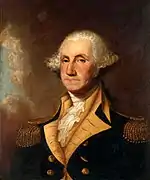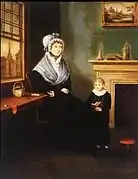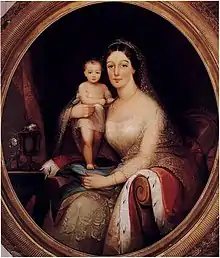Jane Stuart
Jane Stuart (1812[lower-alpha 1] – April 27, 1888[lower-alpha 2]) was an American painter, best known for her miniature paintings and portraits,[2] particularly those made of George Washington.[3] She worked on and later copied portraits made by her father, Gilbert Stuart, and created her own portraits. In the early 19th century, she assumed the responsibility of supporting her family after her father's death. She first worked in Boston, but later moved to Newport, Rhode Island, where she was the first woman who painted portraits. In 2011, she was inducted into the Rhode Island Heritage Hall of Fame.
Jane Stuart | |
|---|---|
| Born | 1812[lower-alpha 1] Boston, Massachusetts |
| Died | April 27, 1888[lower-alpha 2] |
| Resting place | Common Burying Ground, Newport, Rhode Island[1] 41°29′47″N 71°18′56″W |
| Nationality | American |
| Occupation | Painter |
| Known for | Portraits |
| Parent | Gilbert Stuart |
Early life

Jane Stuart, born in 1812[lower-alpha 1] in Boston, Massachusetts, was the youngest child of renowned painter Gilbert Stuart[6] and Charlotte Coates Stuart, who was 13 years his junior and "exceedingly pretty". They were married about September 1786.[7]
The Stuarts had twelve children, five of whom died by 1815 and two others died while they were young, perhaps born after Jane. The known names of the children include Charles Gilbert, Jarvis, Emma, Elizabeth, Anne, Carlisle, Agnes Blagrove, and Jane. Charles had artistic and dramatic talent, Elizabeth was a published writer, and Carlisle was noted for his agreeable disposition and died in 1820, possibly from tuberculosis.[8] Anne lived to 68 years of age, and Elizabeth married a man named Benjamin Stebbins.[9][lower-alpha 3] There were no descendants from the family.[8]
Gilbert Stuart had mental illness for years, but was able to keep it hidden.[10] The children had aspects of a traditional childhood, playing musical instruments and telling stories, but also were subject to a life of emotional turmoil.[8]
Career
Early years and education
When they want to know if a puppy is of the true Newfoundland breed, they throw him into the river; if true, he will swim without being taught.
—Gilbert Stuart, response about why he did not teach his daughter to paint.[6]
Gilbert Stuart believed that true talent did not need instruction, so he did not give his daughter lessons.[6] Instead, Jane learned painting skills by watching him[11] and copying his style,[12] and through lessons by instructors or her brother Charles.[13] She was kept busy by her father grinding paints and filling in backgrounds of his paintings. Stuart later said that she would have preferred it if her father had given her training.[6]
She completed many of her father's partially finished paintings[14] and made her own paintings. Affectionately called "boy" by her father, she was considered by him to be a better painter than he was at the same age. He wanted to, but was unable to, send her to London to study with George Downey.[5] About 1820, she made a portrait of George Washington. It is held at the Kemper Art Museum of the Washington University in St. Louis.[15]
Her father died in 1828. He was not good at managing money and when he died, his family was left in extreme poverty.[2][11] The Boston Athenæum held a benefit exhibition of 250 his works in August 1828 in an effort to provide financial aid for the family.[16]
Stuart opened a studio in Boston and began working as an artist to support her family.[2][11] Three of her siblings—Elizabeth, Emma and an unnamed brother[17]—were committed to psychiatric hospitals following her father's death.[10]
Established career
After 1828, she received commissions to make dozens of miniature and full-sized paintings after the popular works created by her father,[6][12] especially replicas of her father's portraits of President George Washington (1732–1799).[6] Her painting of Washington, patterned after one made by her father, exhibited her skill as an artist, capturing light and depicting facial features and expression.[18] Her paintings were so skillful that the paintings have been confused with the originals by art dealers.[6] She also made paintings after other artists.[6] She exhibited her works at the Boston Athenæum beginning in 1827 and often exhibited her works there and at the National Academy Museum and School in New York City until 1870.[6]
Aside from copying works of others, she also created her own portraits and paintings, which reflected her personal style.[14] She was said to be among the city's best portrait painters based upon her exhibit at the Academy of Fine Arts.[11]
She studied painting in New York. In 1833 she exhibited at the New York Academy of Fine Arts. Besides earning money as a painter, Stuart was also an art teacher.[5] In 1834, she painted Scene from a Novel or a Subject from Literature, now owned by Vanderbilt University in Nashville, Tennessee.[19] She lived in New York between 1840 and 1842, and exhibited her works at the American Academy.[6]
She and her father both worked on a portrait of Oliver Hazard Perry that is held at the Toledo Museum of Art. The museum stated that "Gilbert Stuart was notorious for leaving paintings unfinished and completed only the head. His talented 16-year-old daughter Jane finished the sky, body, and uniform after her father’s death."[20] Her painting A Portrait of Commodore Oliver Hazard Perry belonged to Brown University in Providence, Rhode Island until 1980. It was among nine portraits of prominent Rhode Island men that were given in 1857 to the university.[2][3] It is now among the collection of the Birmingham Museum of Art.[3]
She continued to paint from the 1850s, including making paintings from daguerreotypes.[6] Over her career, she also made religious and genre paintings.[18]
Some of her paintings are Lady Macbeth that has been among the collection of the Morris Museum; The Fortune Teller; Morning, Noon and Night that has been held by the New Britain Museum of American Art, and Costume of Charles the Second's Reign (1876).[21] Her portraits from this period include Alicia Boylston in the collection of the Museum of Fine Arts, Boston[22] and one of her portraits of George Washington, which is held at the Harvard Art Museums.[23] A portrait by her of Thomas Jefferson is at the Strawbery Banke Museum in Portsmouth, NH.
Stuart wrote three articles about her father for Scribner's Monthly between June 1876 and July 1877.[24] She struggled financially, but kept up appearances during the Gilded Age of Newport by selling her father's or her paintings to by-passers.[13]
Personal life
She was a brilliant woman in every respect. Distinguished men and women gathered about her, and in the summer season her pretty cottage was thronged. She was prominent in all literary circles, and her reputation for wit and brilliance extended far outside the limits of New England.
—"Miss Jane Stuart, A Noted Character, Expires at her Newport Home", Detroit Free Press [25]
Stuart remained unmarried throughout her life, but was a matchmaker for others. She was a noted socialite,[12] known for her "droll wit and fascinating personality", like that of her father.[6] Intelligent and playful, she enjoyed dressing up in costumes and playing charades.[13]
Three of her siblings—Elizabeth, Emma and an unnamed brother[17]—were committed to psychiatric hospitals following her father's death.[10]
In 1831, the family moved to Newport, Rhode Island, while she also continued to have a studio in Boston. At this time, she supported her mother and three sisters.[5] Her mother died in 1847 at 77 years of age.[1] In August 1858,[5] many of her paintings were destroyed when her studio burned. She then established a studio in her family home in Newport, Rhode Island.[6] She acquired the house at 86 Mill Street in Newport in 1863.[14]
After a brief illness, she died on April 27, 1888.[1][lower-alpha 2] She is buried at a family monument at the Common Burying Ground in Newport, Rhode Island.[1]
Legacy
Noted as the first woman portraitist of Newport, she was inducted into the Rhode Island Heritage Hall of Fame in 2011.[14] Some of her works are among the collection of the Gilbert Stuart Museum.[4] An exhibit of her and her father's original works was held at the Gilbert Stuart Museum in Saunderstown, Rhode Island from June to October 2016.[26] Her works included in the exhibition included two portraits she made of her father, and portraits of George and Martha Washington.[4]
Her artists file and photographs of her works—acquired from curators, art galleries, and dealers—are held at the Photograph Archives of the Smithsonian American Art Museum[27] and the Library of the Smithsonian American Art Museum and United States.[28]
Gallery
 "Portrait of Oliver Hazard Perry", Toledo Museum of Art
"Portrait of Oliver Hazard Perry", Toledo Museum of Art George Washington, circa 1820, Kemper Art Museum, Washington University in St. Louis
George Washington, circa 1820, Kemper Art Museum, Washington University in St. Louis
 "Interior Scene" of mother and son at lesson, c. 1835, Boston, Massachusetts
"Interior Scene" of mother and son at lesson, c. 1835, Boston, Massachusetts Oliver Hazard Perry, c. 1857
Oliver Hazard Perry, c. 1857
 Morning, Noon and Night, c. 1830-1860, oil on wood panel, New Britain Museum of American Art
Morning, Noon and Night, c. 1830-1860, oil on wood panel, New Britain Museum of American Art Anita Chartrand Little
Anita Chartrand Little
Notes
- She may have been born as early as 1808.[5]
- Obituaries, like that by the Detroit Free Press, state that Stuart died on April 28, 1888,[25] but her headstone identifies the date of death as April 27, 1888.[1]
- Elizabeth married Benjamin Stebbins,[9] but there was confusion about this due to the family monument at the Common Burial Ground in Newport, Rhode Island stated that one of the children was Emma Stebbins, incorrectly inferring that it was Emma that married Stebbins.[1]
References
- "Jane Stuart". Rhode Island Historical Cemetery Commission. 2007. Retrieved February 12, 2017.
- "Oliver Hazard Perry". Brown University Office of the Curator. Retrieved February 14, 2017.
- "Oliver Hazard Perry". Birmingham Museum of Art. Retrieved February 15, 2017.
- Margaret O’Connor (June 25, 2016). "Art Gallery". Gilbert Stuart Birthplace and Museum. Retrieved February 16, 2017.
- Margaret O’Connor (June 25, 2016). "Jane, Heir to the Stuart Genius". Gilbert Stuart Birthplace and Museum. Retrieved February 16, 2017.
- Dale T. Johnson (1990). American Portrait Miniatures in the Manney Collection. New York, New York: The Metropolitan Museum of Art. p. 207. ISBN 9780870995972.
- Dorinda Evans (January 1, 2013). Gilbert Stuart and the Impact of Manic Depression. Ashgate Publishing, Ltd. p. 14. ISBN 978-1-4094-4164-9.
- Dorinda Evans (January 1, 2013). Gilbert Stuart and the Impact of Manic Depression. Ashgate Publishing, Ltd. pp. 111–112. ISBN 978-1-4094-4164-9.
- Dorinda Evans (January 1, 2013). Gilbert Stuart and the Impact of Manic Depression. Ashgate Publishing, Ltd. pp. 5, 8, 115. ISBN 978-1-4094-4164-9.
- Dorinda Evans (January 1, 2013). Gilbert Stuart and the Impact of Manic Depression. Ashgate Publishing, Ltd. p. 129. ISBN 978-1-4094-4164-9.
- Patricia Dunlavy Valenti (2004). Sophia Peabody Hawthorne: 1809-1847. Columbia, Missouri: University of Missouri Press. p. 24.
- "Happy Women's History Month". Birmingham Museum of Art. Retrieved February 15, 2017.
- Newport Historical Society (October 22, 2013). "History Bytes: Jane Stuart". Newport Historical Society. Retrieved January 4, 2017.
- Patrick T. Conley (2011). "Jane Stuart". Rhode Island Heritage Hall of Fame. Retrieved February 15, 2017.
- "George Washington". Kemper Art Museum, Washington University in St. Louis. Retrieved February 16, 2017.
- Swan, Mabel Munson (1940). The Athenæum Gallery 1827–1873: The Boston Athenæum as an Early Patron of Art. Boston: The Boston Athenæum. pp. 62–73.
- Dorinda Evans (January 1, 2013). Gilbert Stuart and the Impact of Manic Depression. Ashgate Publishing, Ltd. p. 123. ISBN 978-1-4094-4164-9.
- Paula E. Calvin; Deborah A. Deacon (2011). American Women Artists in Wartime, 1776-2010. Jefferson, North Carolina: McFarland & Company. pp. 44–46. ISBN 9780786486755.
- "Fine Arts Gallery - Vanderbilt University". Archived from the original on December 29, 2015. Retrieved 4 January 2017.
- "Artwork of the Week: August 9". Toledo Museum of Art. 2013. Archived from the original on February 17, 2017. Retrieved February 16, 2017.
- "Search: Jane Stuart (page 1)". Smithsonian Institution Research Information System. Retrieved February 16, 2017.
- "Alicia Boylston". Museum of Fine Arts, Boston. Retrieved February 16, 2017.
- "George Washington (1732-1799), after Gilbert Stuart (1755-1828)". Harvard Art Museums. Retrieved February 16, 2017.
- James Thomas Flexner (1967). America's Old Masters. Mineola, New York: Courier Dover Publications. p. 351.
- "Miss Jane Stuart, A Noted Character, Expires at her Newport Home". Detroit Free Press. April 29, 1888. p. 3. Retrieved February 13, 2017 – via newspapers.com.
- Margaret O’Connor (June 25, 2016). "Jane, Heir to the Stuart Genius—A Rhode Island Masters Exhibition". Gilbert Stuart Birthplace and Museum. Retrieved February 16, 2017.
- "Jane Stuart: artist file, [photographs]". Photograph Archives, Smithsonian American Art Museum. Retrieved February 16, 2017.
- "Jane Stuart, 1812-1888 [Folder]". Collections Search Center, Smithsonian Institution. Retrieved February 16, 2017.
Further reading
- Hattendorf, Berit M. "Newport First Woman Portraitist: Jane Stuart," Newport History, vol. 67, Issue 232 (1996).
- Opitz, Glenn B., ed. (1987). MantleFielding's Dictionary of American painters, sculptors and engravers. Poughkeepsie, New York: Apollo.
- Powel, Mary E. (January 1, 1920). "Miss Jane Stuart, 1812-1888: Her Grandparents and Parents". Newport Historical Society.
External links
![]() Media related to Jane Stuart at Wikimedia Commons
Media related to Jane Stuart at Wikimedia Commons
- Jane Stuart, Smithsonian Institution Research Information System (SIRIS)